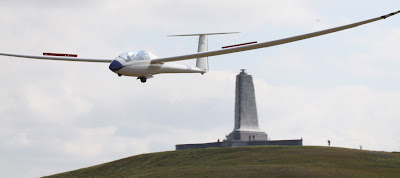| Hooking up and ready for takeoff All photos courtesy of Stefan Trego: http://www.flickr.com/photos/stefantrego/ |
This was my second Snowbird, but the first one where anyone did any flying. Last year's contest was weathered out with winds out of the West at 20 knots and gusting higher. This year was completely different with reasonably calm winds and incredibly warm temperatures into the 60's.
I volunteered to log takeoffs and we kept two tow planes busy all day long with over 60 flights Saturday. We had contestants from Finger Lakes and Valley Soaring and they brought their own 1-26 gliders -the machines of choice for spot landings.
 |
| Preparing to enter downwind for Snowbird. All photos courtesy of Stefan Trego http://www.flickr.com/photos/stefantrego/ |
| On approach during Snowbird. The landing zone is on the right hand runway about 1/3 of the way up from the grass. Can you see it? I didn't think so. All photos courtesy of Stefan Trego http://www.flickr.com/photos/stefantrego/ |
Best landing of the day goes to two of our most experienced instructors -Dana Smith and Ron Ogden who touched down hot and laid down a good 180 feet of skid mark before crushing the traffic cone. While they were a little sheepish, it's nice to know everyone is human.
I didn't fly this year. I intended to hand over the log to someone around 1pm and fly a couple of flights, but pretty much everyone else was flying and there just wasn't anyone to do it until much later when I had obligations at home. Even so, there was so much energy and activity on the flight line, it was still a lot of fun to participate.
I didn't fly this year. I intended to hand over the log to someone around 1pm and fly a couple of flights, but pretty much everyone else was flying and there just wasn't anyone to do it until much later when I had obligations at home. Even so, there was so much energy and activity on the flight line, it was still a lot of fun to participate.
Moving into the winter, we're going to be fairly active with rework on number 3 and buff and polish of the 4 ASK-21's we own. I can't wait until April to fly again!
